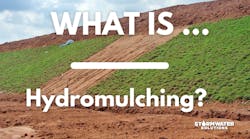What is hydroseeding?
Hydroseeding is the process of applying seed, fertilizer and mulch to land in one step.
According to a State of Michigan document, hydroseeding typically consists of applying a mixture of wood fiber, seed, fertilizer and stabilizing emulsion with hydro-mulch equipment.
This application can temporarily protect exposed soils from erosion by water and wind.
Hydroseeding is also known as hydro mulching, hydraulic planting, hydraulic mulch seeding and hydraseeding.
What are the downsides of hydroseeding?
There are multiple advantages and disadvantages to hydroseeding. According to the State of Michigan document, disadvantages can include the following:
- Requires time: Hydroseeding can be used on its own when there is sufficient time in the season to ensure vegetation establishment and erosion control. Hydroseeding must be used in conjunction with a soil binder otherwise.
- Dry periods: Hydroseeding may be ineffective during dry periods without supplemental irrigation.
- Effectiveness: Wood fiber hydraulic mulches only last a part of a season and need 24 hours to dry before rainfall occurs to be effective.
- Remote areas: It may be difficult to reach remote areas with hydroseeding equipment.
What are the advantages of hydroseeding?
Hydroseeding has multiple benefits. Advantages of hydroseeding according to the State of Michigan include:
- Tackifiers can be used with the application to help keep the seed in place.
- Provides mulching medium around the seed to hold moisture.
Is hydroseeding better than regular seeding?
Hydroseeding is a liquid mixture that is sprayed on top of soil. It contains seeds, mulch, water and fertilizer. Hydroseeding can provide more consistent, more reliable results than conventional seeding.
Due to the mixture and application process, hydroseeding can be more expensive than hand seeding. However, the hydroseeding process allows grass seeds to germinate and grow quicker than traditional seeding.
Hydroseeding may be more beneficial depending on application size, time allotted and the season of planting.
Can hydroseed wash away?
Hydroseed can wash away if the soil has not been properly prepared and is compacted. There is potential for heavy rain to wash away seeds if the rain occurs right after hydroseeding.
Tackifiers can be added to the hydroseed mix to help reduce the chances of seed washing away.
What is an alternative to hydroseeding?
According to the California Department of Transportation (DOT), hydromulching is a similar alternative to hydroseeding. However, hydromulching may or may not include seed in the mixture depending on the application or desired outcome.
The California DOT also states that hand seeding an area smaller than 0.5 acres should be considered over hydroseeding.
What are the limitations of hydroseeding?
Hydroseeding can protect areas from surface erosion and help conserve soil moisture. It also has a low initial cost compared to other treatment methods. The process is meant for cut and fill slopes 2:1 (H:V) and flatter, and larger than 0.5 acres.
Hydroseeding has its limitations when it comes to erosion control, however. The California DOT lists the following as potential limitations:
- Surface treatment only: Hydroseeding does not improve underlying soil structure, improve soil microbiology, restore nutrient reserves or restore compacted soils, and may not provide the conditions necessary for successful vegetation growth.
- Slopes: Higher application rates required for steeper slopes may inhibit germination of seed and establishment of long-term vegetation.
- Other methods: Consider using erosion control (seeding) instead.
- Small areas: Hydroseeding is considered and inefficient technique to treat disturbed land less than 0.5 acre.
About the Author
Alex Cossin
Associate Editor
Alex Cossin is the associate editor for Waterworld Magazine, Wastewater Digest and Stormwater Solutions, which compose the Endeavor Business Media Water Group. Cossin graduated from Kent State University in 2018 with a Bachelor of Science in Journalism. Cossin can be reached at [email protected].




